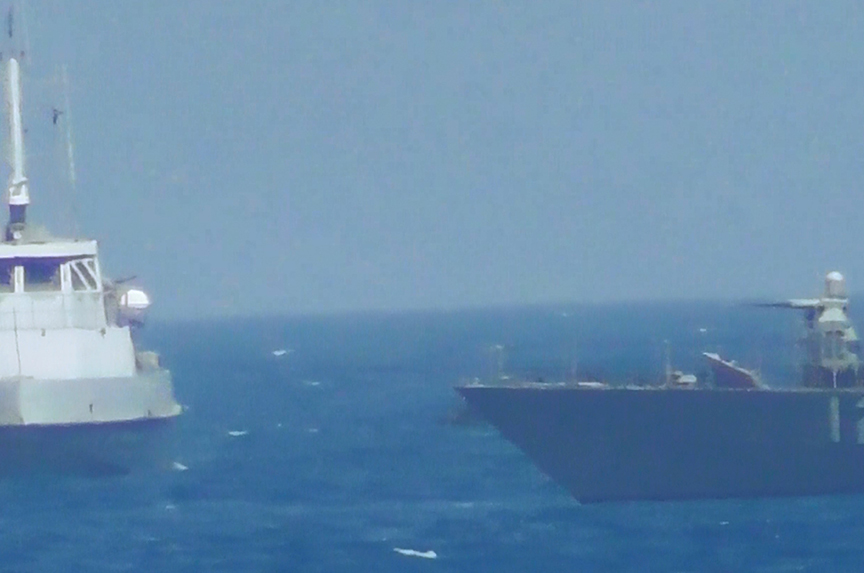
Iran challenges US policy, this time in the maritime domain
It seems hard for the United States to catch a break in the Persian Gulf these days. As its Arab partners continue to bicker among themselves, Iran remains a source of tension from across the water. A week after US President Donald J. Trump reluctantly notified Congress of Iran’s compliance with the nuclear deal and imposed new non-nuclear sanctions, a US Navy ship fired warning shots at a patrol boat operated by Iran’s Islamic Revolutionary Guard Corps (IRGC)-Navy in the Persian Gulf.
The July 25 encounter is yet another reminder that the IRGC-Navy will continue to create dangerous, potentially escalatory situations with US craft in the Gulf. Understanding the nature of Iran’s military forces and the threat they pose highlights both the need for continuing diplomatic engagement and the limits of dialogue with Iranian officials.
Iran uses two sets of naval forces to achieve its maritime interests. The IRGC-Navy employs asymmetric tactics to harry the navies of its neighbors and other foreign states present in the Gulf. The Islamic Republic of Iran Navy (IRIN) is a conventional maritime force that operates in the Caspian Sea and the Gulf of Oman. The IRGC-Navy relies on smaller, faster boats that “buzz” larger craft, driving close to them and often seemingly risking the possibility of a crash, relying on their ability to navigate quickly and in shallower waters. It also relies on its naval aviation and radar capabilities to track adversary forces. For its part, the IRIN relies on larger maritime craft to conduct naval diplomacy and protect Iranian interests largely outside the Gulf, participating in counter-piracy operations and joint exercises with foreign navies (though it also would play a role in any crisis that might occur in the Strait of Hormuz).
In the maritime domain, as elsewhere in the Middle East, it is the IRGC and its affiliates that pose the most direct Iranian challenge to US interests and operations. Ideologically loyal and answering only to Iran’s supreme leader, the IRGC and its navy regularly create headaches for the US Navy by flaunting maritime norms and using asymmetric tactics. This puts US operators on the scene in the position of having to make difficult decisions on whether to engage or ignore IRGC-Navy actions that could have larger strategic or political consequences.
There are two trains of thought on whether maritime incidents like the one on July 25 seriously threaten to escalate to crisis level. The first is that due to the Trump administration’s understaffed diplomatic channels and its general aversion to engaging in open discussions with Iran, the possibility for deconfliction following these types of events is much lower. With the White House diffusing responsibility for operational decision-making and deconfliction apparently off the table, the possibility for a small incident to turn into a larger conflagration is increased. Proponents of deconfliction point to the Obama administration’s ability to negotiate the release of American sailors temporarily held by the IRGC-Navy and the likely inability of the Trump administration to do likewise at present.
The second line of thinking holds that these incidents are not seriously challenging and are, at this point, part of doing business in the Gulf for the US Navy. Buzzing and other asymmetric events have occurred regardless of whether there was political dialogue between the United States and Iran, largely as a function of the IRGC’s greater loyalty to Iran’s supreme leader than to its elected government and bureaucrats, with whom the Obama administration maintained diplomatic channels. While open lines of communication might help in situations where the IRGC-Navy’s actions could set off a true military or political crisis, they will not in themselves deter Iranian maritime harassment in the Gulf.
There is truth to both perspectives. So long as the revolutionary regime in Tehran remains in charge, the IRGC will maintain carte blanche to pester and try to provoke the United States throughout the region and across domains. Nonetheless, the ability to avoid crisis, as the Obama administration did by negotiating the release of the American sailors last year, will remain important to maintaining what stability is left in the region.
The Trump administration needs to ensure it is striking the correct balance between diplomatic engagement and containment of Iranian threats in general, but particularly in the maritime realm. Sanctions imposed by the Trump administration on July 18 that target IRGC-Navy fast attack craft, ballistic missiles, unmanned aerial vehicles (UAVs) and other materiel get directly at addressing tools the IRGC uses to contribute to regional instability. They address threats to US operators, partners, and interests.
But the administration lacks deconfliction channels at the political level, and Trump has not shied away from using inflammatory rhetoric on Iran. His national security team, in particular Defense Secretary James Mattis, is already known for its tough views on Iran; ongoing presidential chatter about blowing up the Joint Comprehensive Plan of Action (JCPOA)—the multilateral deal meant to curb Iran’s nuclear capabilities—could be detrimental if a crisis requiring high-level dialogue were ever to arise.
It is likely only a matter of time before the IRGC-Navy tries to provoke US forces again. With the current state of the Gulf’s politics and security affairs a roiling cauldron, it will take level heads and steady hands to ensure that IRGC mischief doesn’t lead to escalation that tips the pot.
Owen Daniels is assistant director of the Middle East Peace and Security Initiative in the Atlantic Council’s Brent Scowcroft Center on International Security. Follow him on Twitter @OJDaniels.
Image: An Iranian vessel steered close to the USS Thunderbolt (right) in the Persian Gulf in a still image from video provided by the US Navy on July 25. (US Navy/Handout via Reuters)
